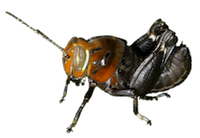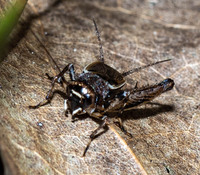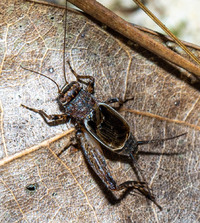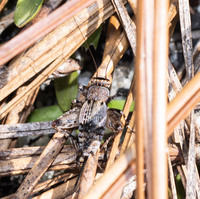Family (Alpha): ACRIDIDAE GRYLLACRIDIDAE GRYLLIDAE GRYLLOTALPIDAE RHAPHIDOPHORIDAE ROMALEIDAE TETRIGIDAE TETTIGONIIDAE TRIDACTYLIDAE
View Gryllidae Members:
Acheta domesticus Anurogryllus arboreus Gryllus unidentified species Gryllus firmus Gryllus fultoni Gryllus pennsylvanicus Gryllus pennsylvanicus/veletis Gryllus pennsylvanicus-veletis Gryllus rubens Gryllus veletis Miogryllus verticalis Velarifictorus micado Hapithus agitator Orocharis unidentified species Orocharis luteolira Orocharis saltator Cycloptilum unidentified species Cycloptilum bidens Cycloptilum pigrum Cycloptilum slossoni Cycloptilum tardum Cycloptilum trigonipalpum Cycloptilum velox Myrmecophilus pergandei Allonemobius allardi Allonemobius fultoni Allonemobius griseus griseus Allonemobius griseus funeralis Allonemobius maculatus Allonemobius socius Allonemobius sparsalsus Allonemobius tinnulus Allonemobius walkeri Allonemobius unidentified species Eunemobius carolinus Eunemobius confusus Eunemobius melodius Eunemobius unidentified species Neonemobius cubensis Neonemobius palustris Neonemobius variegatus Pictonemobius ambitiosus complex Pictonemobius ambitiosus Pictonemobius hubbelli Nemobiinae unidentified species Oecanthus unidentified species Oecanthus celerinictus Oecanthus exclamationis Oecanthus fultoni Oecanthus latipennis Oecanthus nigricornis Oecanthus niveus Oecanthus pini Oecanthus quadripunctatus Neoxabea bipunctata Phyllopalpus pulchellus Anaxipha delicatula Anaxipha exigua Anaxipha litarena Anaxipha rosamacula Anaxipha thomasi Anaxipha tinnula Anaxipha tinnulacita Anaxipha tinnulenta Anaxipha vernalis Anaxipha new species near vernalis Anaxipha unidentified species Cyrtoxipha columbiana Falcicula hebardi Gryllidae unidentified species NC Records
Pictonemobius hubbelli Walker & Mays, 1990 - Hubbell's Ground Cricket
Taxonomy
Family: Gryllidae
Subfamily: NemobiinaeTribe: PteronemobiiniComments: One of four species in this genus, all of which are endemic to southeastern North America (Gross et al., 1989; Cigliano et al., accessed 2021-10-10). As many as two species may occur in North Carolina; the other two are primarily or exclusively Floridian.Species Status: Considered a single species -- ambitiosus -- until Gross et al. (1989) recognized three additional siblings based on songs, electrophoretic analysis, and at least partially on morphological differences. Specimens collected by Fulton (listed by Brimley, 1938), were identified as ambitiosus , but could be either the species now recognized as ambitiosus or hubbelli , which can only be distinguished by song. Both have been documented in South Carolina and seem equally likely to be the one collected by Fulton; the other two species have only been recorded in Florida or extreme southern Georgia. Although Fulton (1931) describes the song of ambitiosus , his account was based on individuals he heard in Florida and he lacked the equipment required to make an accurate measurement of pulse rate, which is needed to distinguish ambitiosus from hubbelli .
Identification
Field Guide Descriptions: Online Photographs: SINA, Google Images ,
iNaturalist , GBIF Technical Description, Adults/Nymphs: Gross et al (1989); Brimley (1938); Hebard (1913)SINA 528a.htm Comments: As in other members of this genus, a distinctive pale stripe exists between the eyes on the frons. This species may be superficially indistinguishable from ambitiosus (see key in Gross et al., 1989), although the body in hubbelli is dark gray-brown but may be more reddish-brown in ambitiosus. In both of these species the hind femora possess two longitudinal stripes and the dorsal field of the tegmina in the males have a pale border. The two other species lack these characters.Structural Features: Femur length is 5.8 mm in the holotype male and 6.11 mm in the allotype female (Gross et al., 1989). The ovipositor length is 6.07 mm in the allotype. Hindwings are absent (Gross, et al., 1989)Singing Behavior: Male calling songs consist of short trills (= "chirps" as defined by Gross et al., 1989), separated by pauses of uniform length. The pulse rate in hubbelli is the slowest of the four species identified by Gross et al., ranging from 29 to 42 PPS. The trill length is generally 1 sec. but was 1.5 seconds in a South Carolina population and 0.5 in some populations further south (Gross et al., 1989). The dominant frequency at 25 C is 6.4 kHz (SINA, accessed 2021-10-10) and the pulse rate at that temperature is 38 PPS (Gross et al.).Diagnostic Song Parameters: Recording playback at normal speed.
Download Video:
"MP4"
Distribution in North Carolina
County Map: Clicking on a county returns the records for the species in that county.
Adult Dates: Click on graph to enlarge
Habitats and Life History
Habitats: The habitat described for this species by Gross et al. (1989) consists of open pine and oak woodlands, including grass tussocks next to pond edges in such habitats. Diet: Probably omnivorousObservation Methods: Males sing primarily during the day and are most easily detected by their songs (Gross et al., 1989)Abundance/Frequency: Locally common at several sites in the SandhillsAdult Phenology:
Status in North Carolina
Natural Heritage Program Status: [W3]Natural Heritage Program Ranks: [GNR] S1S3State Protection: Comments: Members of this genus have been rarely collected even in South Carolina and the only historic records we have from North Carolina are for the specimens collected by Fulton in the 1930s. Although more needs to be learned about the species we have, their distribution and abundance, and their habitat associations, Gross et al. (1989) found that populations appeared to be highly isolated from one another, as demonstrated by large differences in their electrophoretic allozymes and other characters. In species associated with narrowly distributed habitats, such as these species seem to be, the lack of dispersal often means that they are highly vulnerable to the effects of habitat fragmentation. There is at least the possibility, therefore, that this species (or group of species) could be of significant conservation concern in North Carolina.
Image Gallery for Pictonemobius hubbelli - Hubbell's Ground Cricket Recorded by: Steve Hall, Mark Basinger, and Gary Perlmutter Recorded by: Mark Basinger and Donald Zepp Recorded by: Stephen Hall Recorded by: Steve Hall Recorded by: Steve Hall and Carol Tingley Recorded by: Steve Hall and Carol Tingley Recorded by: Steve Hall and Carol Tingley Recorded by: Steve Hall and Bo Sullivan Recorded by: Steve Hall and Bo Sullivan

 »
»



 »
»

